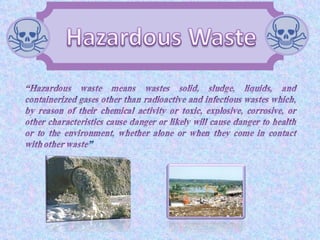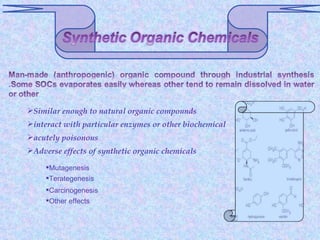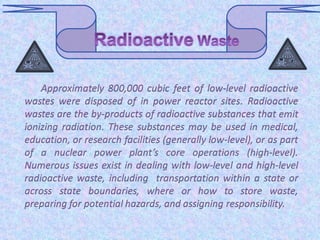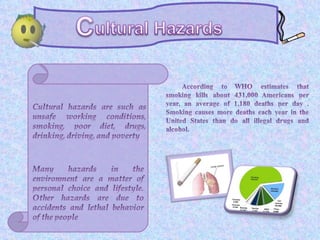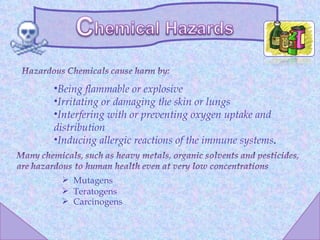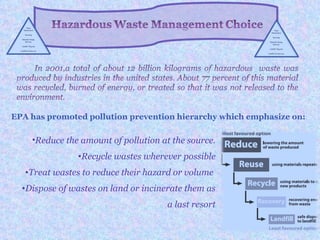Hazardous waste
- 5. Listed hazardous wastes are generated by specific industries and processes EP A and are automatically considered hazardous, based solely on the process that generates them and irrespective of whether a test of the waste shows any Example of the "characteristics" of hazardous waste •sludge leftover from electroplating processes. •waste from iron and steel manufacturing •certain cleaning and/or degreasing processes
- 6. Heavy Metals Halogenated Hydrocarbons Synthetic Organic Chemicals Radioactive Waste ry r cu c Me Tin C hr Zin om um d mi iu Ca m Lead e r pp Co
- 7. Similar enough to natural organic compounds interact with particular enzymes or other biochemical acutely poisonous Adverse effects of synthetic organic chemicals Mutagenesis Terategenesis Carcinogenesis Other effects
- 10. Cultural Hazards Biological Hazards Chemical Hazards Physical Hazards
- 12. •Being flammable or explosive •Irritating or damaging the skin or lungs •Interfering with or preventing oxygen uptake and distribution •Inducing allergic reactions of the immune systems. Mutagens Teratogens Carcinogens
- 13. Mutagens are agents, such as chemicals and ionizing radiation, that cause random mutations, or changes in the DNA molecules found in cells Disease such as manic depression, cystic fibrosis, hemophilia, sickle cell anemia, Down’s Syndrome, and some types of Cancer.
- 14. PCBs, thalidomide, steroid hormones and heavy metals such as arsenic ,cadmium, lead and mercury.
- 15. Approximately 31%of the 56millions deaths in 1999 were due to infectious and parasitic diseases.the leading causes of death in this category are the acute respiratory infections e.g., pneumonia, diphtheria, tuberculosis, whooping cough ,influenza and streptococcal infections, both viral and bacterial
- 17. •generally pose a lower threat relative to other hazardous wastes •Are ubiquitous and produced in very large quantities by a large number of generators. Some of the most common "universal wastes" are: fluorescent light bulbs, some specialty batteries (e.g. lithium or lead containing batteries), cathode ray tubes, and mercury-containing devices In worldwide, The United Nations Environmental Programme (UNEP) estimated that more than 400 million tons of hazardous wastes are produced universally each year, mostly by industrialized countries1
- 18. The following list includes categories often applied to HHW: •Automotive wastes (used motor oil, antifreeze, etc.) •Pesticides (insecticides, herbicides, fungicides, etc.) •Electronics (computers, televisions, cell phones) •Aerosols / Propane cylinders •Caustics / Cleaning agents •Ammunition •Refrigerant-containing appliances •Mercury-containing wastes (thermometers, switches, fluorescent lighting, etc) •Some specialty Batteries (e.g. lithium, nickel cadmium, or button cell batteries)
- 19. Hazardous wastes are generated from wide range of industrial, agricultural, commercial and household activities ON –Site Waste :After the waste is generated, if it is managed onsite by the generator , then it is called ‘on-site waste.’ Off- Site Waste :If the waste is transported off-site for treatment, disposal, and recycling to any site, other than where it was generated, it is called ‘off-site waste” Companies that make metal products Hospitals and Doctors Fuel stations Dry cleaners Photo Developing centers Farming Construction Auto repair facilities Research Facilities Your own homes
- 20. Most of the hazardous wastes are chemical wastes and their control is extremely difficult. Roughly 1000 new chemicals are released per year and all of them are toxic (though less toxic to effect human health). Hazardous wastes cause many diseases in humans and other animal life. For example, high concentration of Arsenic and other heavy metals can cause diseases like diarrhea Hepatitis A and E Dysentery Diabetes mellitus Bronchitis Heart diseases (heart attack) Chronic airway obstruction Lymphoma (tumors in the lymph) Cancer of the lungs, bladder, skin, kidney, nose and liver Hypertension, hypersensitive heart disease
- 21. EPA has promoted pollution prevention hierarchy which emphasize on: •Reduce the amount of pollution at the source. •Recycle wastes wherever possible •Treat wastes to reduce their hazard or volume •Dispose of wastes on land or incinerate them as a last resort
- 22. Many times it is possible to use waste in any other purpose which eliminates it as a waste. E.g.: Waste oils can be used as fuels for power plants. Involves burning waste at high temperatures and can be used to destroy a variety of kinds of wastes. A hazardous waste incinerator can be used to burn organic wastes but is unable to destroy inorganic wastes. a well designed and well run incinerator can destroy 99.9999 percent of the hazardous waste that go through it. The relatively high costs of incineration and concerns about the emissions affecting surrounding areas have kept incineration from becoming a major method of treatment or disposal.
- 23. Land disposal can take several forms: Deep well injection into porous geological formations or salt caverns Discharge of treated and untreated liquids into municipal sewers, rivers, and streams Placement of liquid wastes or sledges in surface pits, ponds, or lagoons Storage of solid wastes in specially designed hazardous waste landfills
- 24. Fundamentally, the goal of a hazardous waste management program is to change the behavior of those who generate hazardous wastes so that they routinely store, transport, treat dispose of them in an environmentally safe manner. Hazardous waste management programs typically evolve through the following stages: Identifying the problem and enacting legislation Designating a lead agency Establishing rules and regulations, developing treatment and disposal capacity Creating a compliance and enforcement program
- 25. ON the basis of above study it is recommended that Hazardous Wastes are a potential source of pollution for our environment. They should be produced in as little quantities as possible. The laws and regulations formulated for the treatment and disposal of hazardous waste should be strictly implemented They should be recycled or treated properly and if they are non degradable, then disposed in a way that they do not cause any damage to our health and environment. ZAHIDA UMAR GC, University, Lahore

